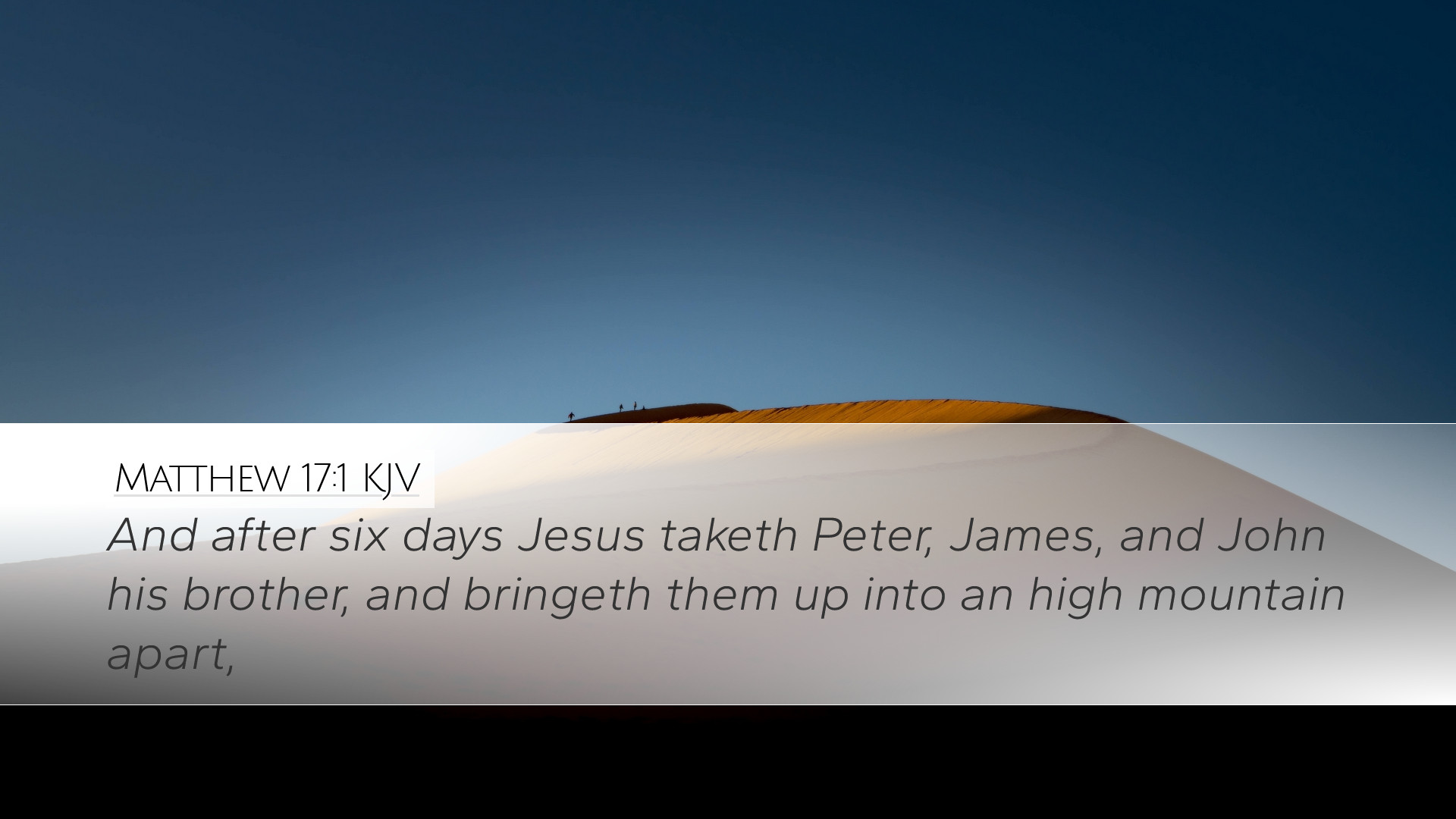Commentary on Matthew 17:1
Verse Context: Matthew 17:1 states, "And after six days Jesus taketh Peter, James, and John his brother, and bringeth them up into an high mountain apart." This significant event is often referred to as the Transfiguration of Jesus Christ.
Overview of the Passage
The Transfiguration occurs after a defining moment in the ministry of Jesus where he predicts his suffering and death. This event serves as a pivotal point in the narrative, providing a divine affirmation of Jesus' identity and mission.
Insights from Commentators
Matthew Henry
Matthew Henry focuses on the selectivity of the witnesses to the Transfiguration. He notes that only Peter, James, and John were chosen to witness this glorious event, suggesting that spiritual privilege often comes with responsibility. Henry emphasizes that this revelation was meant to prepare the disciples for the future trials they would face, especially after Jesus' impending crucifixion.
Albert Barnes
Albert Barnes elaborates on the six days that preceded the event, suggesting that it signifies a period of solemn preparation. He points out that this timeframe mirrors the pattern found in the Old Testament, where waiting often precedes divine revelation. Barnes argues that this moment was intended for the disciples to realize the divine nature of Jesus, affirming his authority and the fulfillment of the Law and the Prophets as seen in the figures of Moses and Elijah during the Transfiguration.
Adam Clarke
Adam Clarke provides a thorough examination of the high mountain where this event took place. He suggests that the mountain symbolizes a place of elevation, both physically and spiritually, representing closeness to God. Clarke also reflects on the significance of the three apostles: Peter, as the spokesperson; James, who would later be the first martyr; and John, who would have a unique intimacy with Jesus. This chosen trio signifies the importance of different roles within the community of Christ's followers.
Theological Implications
The Transfiguration reveals the profound truth of Jesus' dual nature—fully divine and fully human. It serves as an epiphany of Christ's glory and underscores the necessity of divine transformation in the lives of believers. This event is not just about witnessing glory; it is a call to transformation for all who follow Christ.
Affirmation of Christ's Divinity
- Manifestation of Glory: This event provides direct evidence of Jesus' divinity, as he is seen in his heavenly glory.
- Connection to the Law and the Prophets: The appearance of Moses and Elijah underscores Christ's fulfillment of the Old Testament.
Preparation for Suffering
The choice of particular disciples to witness the Transfiguration reflects Jesus' intent to prepare them for the coming suffering. The glory that they beheld would not only strengthen them in their faith but also serve as a crucial counterbalance to the despair they would face at the crucifixion.
Practical Applications
This passage offers rich theological insights and practical applications for contemporary believers, revealing how moments of divine glory can fortify faith amidst trials.
- The Importance of Spiritual Experiences: Just as the disciples experienced transformative moments with Christ, modern believers should seek a closer relationship with God through prayer and worship.
- The Role of Community: The selection of Peter, James, and John emphasizes the strength found in Christian fellowship. Believers are encouraged to surround themselves with others who can support them during spiritual highs and lows.
- Expectation of Suffering: Understanding that moments of glory are often followed by trials can prepare believers to remain steadfast in faith.
Conclusion
Matthew 17:1 and the subsequent Transfiguration narrative serve as a powerful reminder of the intersection between divine revelation and human experience. The insights provided by Matthew Henry, Albert Barnes, and Adam Clarke collectively illustrate the profound significance of this moment in the life of Jesus and his followers. For pastors, students, theologians, and scholars, this passage provides a rich tapestry of theological truth that emphasizes the glory of Christ while preparing believers for the challenges of faith.


